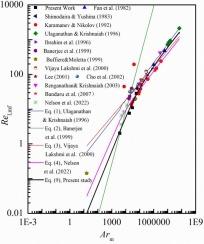中试规模液固反向流化床的基本流体力学
IF 4.5
2区 工程技术
Q2 ENGINEERING, CHEMICAL
引用次数: 0
摘要
设计并安装了一个内径 0.33 米、高 3.0 米的中试规模液固反向流化床(LSIFB)。使用不同直径和密度的颗粒对基本流体力学进行了实验研究。最小流化速度随颗粒直径的增大和颗粒密度的减小而增大,与颗粒装载量无关。研究人员收集了 48 组最小流化速度数据,并结合文献进行总结,通过修改 Wen 和 Yu 方程建立了一个经验方程。修正后的方程可以有效预测阿基米德数大范围内的最小流化速度。床层膨胀率随液体速度和颗粒密度的增加而增加,但随颗粒直径的增加而减小。根据床层膨胀特性,通过关联阿基米德数和雷诺数,提出了一个经验方程,以成功预测床层膨胀。本文章由计算机程序翻译,如有差异,请以英文原文为准。

Basic hydrodynamics of a pilot-scale liquid-solid inverse fluidized bed
A pilot-scale liquid-solid inverse fluidized bed (LSIFB) with 0.33 m in inner diameter and 3.0 m in height was designed and installed. Basic hydrodynamics were investigated experimentally using particles with different diameters and densities. The minimum fluidization velocity increases with the increase of particle diameter and the decrease of particle density and is independent of particle loading. Forty eight sets of data on minimum fluidization velocities from the investigation combined with the literature were collected and summarized to establish an empirical equation by modifying the Wen and Yu equation. The modified equation can predict effectively the minimum fluidization velocity across a wide range of Archimedes number. The bed expansion ratio increases with liquid velocity and particle density but decreases with the increase of particle diameter. Based on the bed expansion characteristics, an empirical equation was proposed by correlating Archimedes number and Reynolds number to predict successfully the bed expansion.
求助全文
通过发布文献求助,成功后即可免费获取论文全文。
去求助
来源期刊

Powder Technology
工程技术-工程:化工
CiteScore
9.90
自引率
15.40%
发文量
1047
审稿时长
46 days
期刊介绍:
Powder Technology is an International Journal on the Science and Technology of Wet and Dry Particulate Systems. Powder Technology publishes papers on all aspects of the formation of particles and their characterisation and on the study of systems containing particulate solids. No limitation is imposed on the size of the particles, which may range from nanometre scale, as in pigments or aerosols, to that of mined or quarried materials. The following list of topics is not intended to be comprehensive, but rather to indicate typical subjects which fall within the scope of the journal's interests:
Formation and synthesis of particles by precipitation and other methods.
Modification of particles by agglomeration, coating, comminution and attrition.
Characterisation of the size, shape, surface area, pore structure and strength of particles and agglomerates (including the origins and effects of inter particle forces).
Packing, failure, flow and permeability of assemblies of particles.
Particle-particle interactions and suspension rheology.
Handling and processing operations such as slurry flow, fluidization, pneumatic conveying.
Interactions between particles and their environment, including delivery of particulate products to the body.
Applications of particle technology in production of pharmaceuticals, chemicals, foods, pigments, structural, and functional materials and in environmental and energy related matters.
For materials-oriented contributions we are looking for articles revealing the effect of particle/powder characteristics (size, morphology and composition, in that order) on material performance or functionality and, ideally, comparison to any industrial standard.
 求助内容:
求助内容: 应助结果提醒方式:
应助结果提醒方式:


